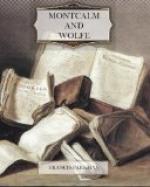[Footnote 18: Journal of Christopher Gist, in appendix to Pownall, Topographical Description. Mr. Croghan’s Transactions with the Indians in N.Y. Col. Docs., VII. 267.]
All looked well for the English in the West; but under this fair outside lurked hidden danger. The Miamis were hearty in the English cause, and so perhaps were the Shawanoes; but the Delawares had not forgotten the wrongs that drove them from their old abodes east of the Alleghanies, while the Mingoes, or emigrant Iroquois, like their brethren of New York, felt the influence of Joncaire and other French agents, who spared no efforts to seduce them.[19] Still more baneful to British interests were the apathy and dissensions of the British colonies themselves. The Ohio Company had built a trading-house at Will’s Creek, a branch of the Potomac, to which the Indians resorted in great numbers; whereupon the jealous traders of Pennsylvania told them that the Virginians meant to steal away their lands. This confirmed what they had been taught by the French emissaries, whose intrigues it powerfully aided. The governors of New York, Pennsylvania, and Virginia saw the importance of Indian alliances, and felt their own responsibility in regard to them; but they could do nothing without their assemblies. Those of New York and Pennsylvania were largely composed of tradesmen and farmers, absorbed in local interests, and possessed by two motives,—the saving of the people’s money, and opposition to the governor, who stood for the royal prerogative. It was Hamilton, of Pennsylvania, who had sent Croghan to the Miamis to “renew the chain of friendship;” and when the envoy returned, the Assembly rejected his report. “I was condemned,” he says, “for bringing expense on the Government, and the Indians were neglected."[20]
[Footnote 19: Joncaire made anti-English speeches to the Ohio Indians under the eyes of the English themselves, who did not molest him. Journal of George Croghan, 1751, in Olden Time, I. 136.]
[Footnote 20: Mr. Croghan’s Transactions with the Indians, N.Y. Col. Docs., VII. 267.]
In the same year Hamilton again sent him over the mountains, with a present for the Mingoes and Delawares. Croghan succeeded in persuading them that it would be for their good if the English should build a fortified trading-house at the fork of the Ohio, where Pittsburg now stands; and they made a formal request to the Governor that it should be built accordingly. But, in the words of Croghan, the Assembly “rejected the proposal, and condemned me for making such a report.” Yet this post on the Ohio was vital to English interests. Even the Penns, proprietaries of the province, never lavish of their money, offered four hundred pounds towards the cost of it, besides a hundred a year towards its maintenance; but the Assembly would not listen.[21] The Indians were so well convinced that a strong English trading-station in their country would add to their safety and comfort, that when Pennsylvania refused it, they repeated the proposal to Virginia; but here, too, it found for the present little favor.




